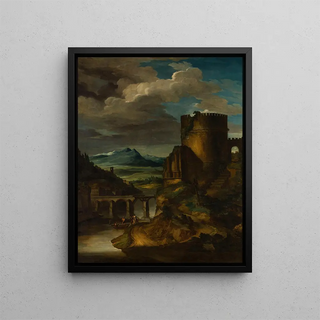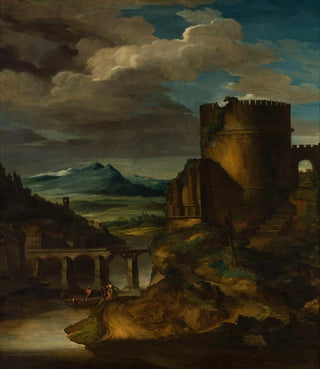Art print | Italian landscape at the tomb - Théodore Géricault


View from behind

Frame (optional)
In the fascinating universe of art, some works manage to capture the collective imagination, transcending eras and styles. "Italian Landscape at the Tomb" by Théodore Géricault is one of these iconic creations. Painted in the early 19th century, this piece stands out for its atmosphere that is both melancholic and serene, inviting the viewer to immerse themselves in a landscape where nature and humanity coexist harmoniously. The canvas evokes timeless beauty, revealing nuances of light and subtleties of everyday life in Italy. By contemplating this work, one feels a deep connection with the past, an invitation to explore the feelings and reflections it inspires.
Style and uniqueness of the work
Géricault's style in "Italian Landscape at the Tomb" is characterized by a romantic approach, where nature is depicted with rare emotional intensity. The vibrant colors and striking contrasts testify to a keen sense of observation and impressive technical mastery. The forms are both realistic and idealized, creating a poetic atmosphere that transports the viewer into a dream world. The composition, skillfully orchestrated, guides the eye across the painting, revealing subtle details that invite prolonged contemplation. Shadows and lights play a crucial role, conferring depth and an almost tactile dimension to the scene. Géricault thus succeeds in capturing not only a landscape but also an emotion, a story, a moment frozen in time.
The artist and his influence
Théodore Géricault, an emblematic figure of the Romantic movement, left a mark on art history through his boldness and creativity. His career, though tragically cut short, was marked by major works that question the human condition and passions. Géricault was not just a painter but also a pioneer, exploring themes such as suffering, death, and beauty. His commitment to the social reality of his time is reflected in his thematic choices, but also in his technique. "Italian Landscape at the Tomb" bears witness to this duality, where the beauty of the

Matte finish

View from behind

Frame (optional)
In the fascinating universe of art, some works manage to capture the collective imagination, transcending eras and styles. "Italian Landscape at the Tomb" by Théodore Géricault is one of these iconic creations. Painted in the early 19th century, this piece stands out for its atmosphere that is both melancholic and serene, inviting the viewer to immerse themselves in a landscape where nature and humanity coexist harmoniously. The canvas evokes timeless beauty, revealing nuances of light and subtleties of everyday life in Italy. By contemplating this work, one feels a deep connection with the past, an invitation to explore the feelings and reflections it inspires.
Style and uniqueness of the work
Géricault's style in "Italian Landscape at the Tomb" is characterized by a romantic approach, where nature is depicted with rare emotional intensity. The vibrant colors and striking contrasts testify to a keen sense of observation and impressive technical mastery. The forms are both realistic and idealized, creating a poetic atmosphere that transports the viewer into a dream world. The composition, skillfully orchestrated, guides the eye across the painting, revealing subtle details that invite prolonged contemplation. Shadows and lights play a crucial role, conferring depth and an almost tactile dimension to the scene. Géricault thus succeeds in capturing not only a landscape but also an emotion, a story, a moment frozen in time.
The artist and his influence
Théodore Géricault, an emblematic figure of the Romantic movement, left a mark on art history through his boldness and creativity. His career, though tragically cut short, was marked by major works that question the human condition and passions. Géricault was not just a painter but also a pioneer, exploring themes such as suffering, death, and beauty. His commitment to the social reality of his time is reflected in his thematic choices, but also in his technique. "Italian Landscape at the Tomb" bears witness to this duality, where the beauty of the






